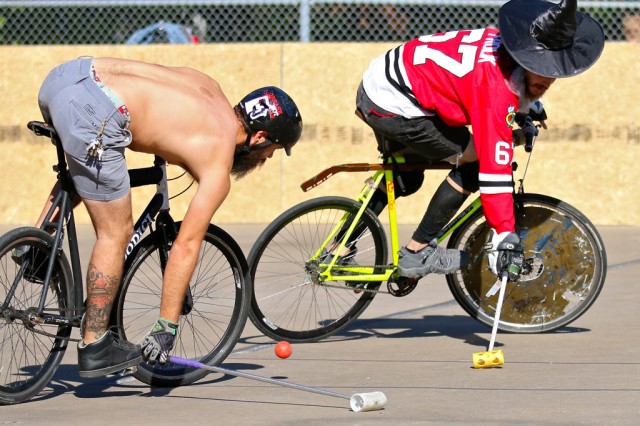Bike Polo Turns a Corner, Finds Enthusiasts around the Globe

Players fight for the ball during a bike polo game at South Austin Recreation Center. Bike polo has grown into a network of 478 social clubs across 55 countries. Photo by Thalia Juarez/Reporting Texas
By Gabriel Macias
For Reporting Texas
It is a vibrant day under an incandescent sky at South Austin Park. Music blares as a crowd gathers around the basketball courts.
The courts are surrounded and separated by a wall of 4-foot high plywood. Sponsor logos spray painted in black are scattered along the inside of the wooden enclosures, adding to the palpable homemade atmosphere.
“Get on that pony!” a spectator shouts, as a fallen comrade struggles to recover from a tumble on a bike.
“You’re terribly mediocre!” another person shouts from the distance — encouragingly friendly banter aimed at people whipping around a concrete floor in a heated three-on-three bike polo match.
Good fun continues to resonate from the Co-Ed Halloween Massacre-ade Ball Tournament, organized by the Austin Texas Bike Polo Social Club on the first weekend of November.
The co-ed tournament consists of 32 three-player teams with at least one woman. It brought together not only Texans, but teams from Canada, Alaska, Pennsylvania, California and many other regions.
People watch in amazement. Some wonder out loud what the rules are to play this apparent field hockey game on bikes.
“You can’t put your foot down,” said event organizer Jasmine Jones, 30, a native of Pittsfield, Maine, and owner of the bakery, I Knead That. “When you shoot the ball, you have to shoot from the small end of the mallet. The third and final rule is don’t be a dick.”
Though it is a new sport to most, bike polo was invented in 1891 by an Irishman, Richard J. Mecredy, as an alternative to horse polo. It was intended to be played on grass fields. The sport also featured in the 1908 Olympic Games.
The game has been in underground circuits ever since. It enjoyed a mild comeback in the 1930s and saw a resurgence in Seattle in the late 1990s.
Bike polo made a full transition to hard courts, and was used as a way to pass the time for area bike messengers. It has grown into a self-governing network of 478 social clubs spanning 55 countries.
The United States has 188 bike polo clubs, more than six times as many as any other country. Texas has 11, more than most countries. All are governed locally with official rules set up by the North American Hardcourt Bike Polo Association.
Each 12-minute tournament game is played at a frenetic pace. A contest starts with a “joust,” or race to control the ball — a process that resembles the opening of a dodgeball match.
Polo mallets are used to smack the ball around. The mallets are basically modified ski poles with a small hollow tube connected to a metal shaft. Balance is key, with most players opting to also use the mallet as a kickstand to avoid touching the pavement.
There are no positions, so communication is a must. Players rotate at goalie or attack at full strength, leaving their own goal defenseless.
The game is often played in tight corners. Bikes can jumble up quickly along any edge of the sideline. Control and balance are crucial when backing up or turning at a sharp angle. Some players choose to hop on their bikes to turn at a dead stop. The bike is lifted a few inches off the ground several times in succession. Remarkably, most players remain upright as they hop.
Dasha Kornienko of Vancouver, Canada, is a bike polo enthusiast and student of the game. “It’s so accessible, you can play on any bike when you’re starting out,” she said.
She knows bike polo started from a mainly DIY culture, with homemade equipment. But things are much different today. Companies now manufacture mallet heads, shafts, disc rotor guards, and much more.
“Polo specific frames for bikes are being made all over the world,” Kornienko said.
The hockey-sized goals are guarded by any means necessary. Teams often crowd their own goal to prevent a score. Plastic wheel covers that fully conceal tire spokes are sometimes used. They are shields against fierce slap shots that are sometimes the full length of the court. Helmets are the only safety gear required.
Mari Jo Moreno, a Dallas resident and aspiring occupational therapist, was apprehensive about bike polo initially. She now plays two or three times a week.
“It’s awesome,” she said. “Best thing I could have done for myself.”
Tommy Sutra has been playing bike polo for 10 years. He has seen the sport grow progressively over the years through word of mouth, with very little promotion.
“Some experience is helpful, but it’s not necessary,” Sutra said.
Jasmine Jones, a bike polo veteran since 2009, has seen the sport grow considerably in recent years. Worldwide support continues to strengthen as tournaments get bigger and more competitive.
“This is what builds the community in terms of having this social network all over the globe,” said Jones. “People come to see us, we make friends and we’ll go travel and see them.”